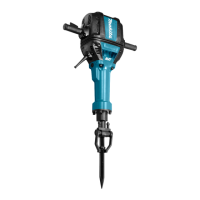2
ENGLISH (Original instructions)
SPECIFICATIONS
Model HM1802 HM1812
Blows per minute 870
Dimensions 843 x 210 x 608 mm
Net weight 29.4 kg 31.3 kg
Safety class /II
• Due to our continuing program of research and development, the specifications herein are subject to change without notice.
• Specifications may differ from country to country.
• Weight according to EPTA-Procedure 01/2003
END201-7
Symbols
The following show the symbols used for the equipment.
Be sure that you understand their meaning before use.
・ Read instruction manual.
・ DOUBLE INSULATION
・ Only for EU countries
Do not dispose of electric equipment
together with household waste
material!
In observance of the European
Directive, on Waste Electric and
Electronic Equipment and its
implementation in accordance with
national law, electric equipment that
have reached the end of their life must
be collected separately and returned to
an environmentally compatible
recycling facility.
ENE046-1
Intended use
The tool is intended for heavy chiselling and demolition
work as well as for driving and compacting with
appropriate accessories.
ENF002-2
Power supply
The tool should be connected only to a power supply of
the same voltage as indicated on the nameplate, and
can only be operated on single-phase AC supply. They
are double-insulated and can, therefore, also be used
from sockets without earth wire.
ENG905-1
Noise
The typical A-weighted noise level determined
according to EN60745:
Model HM1802
Sound pressure level (L
pA
) : 95 dB (A)
Sound power level (L
WA
) : 106 dB (A)
Uncertainty (K) : 3 dB (A)
Model HM1812
Sound pressure level (L
pA
) : 96 dB (A)
Sound power level (L
WA
) : 107 dB (A)
Uncertainty (K) : 3 dB (A)
Wear ear protection
ENG900-1
Vibration
The vibration total value (tri-axial vector sum)
determined according to EN60745:
Model HM1802
Work mode : chiselling
Vibration emission (a
h,CHeq
) : 14.0 m/s
2
Uncertainty (K) : 1.5 m/s
2
Model HM1812
Work mode : chiselling
Vibration emission (a
h,CHeq
) : 6.5 m/s
2
Uncertainty (K) : 1.5 m/s
2
ENG901-1
•
The declared vibration emission value has been
measured in accordance with the standard test
method and may be used for comparing one tool
with another.
• The declared vibration emission value may also be
used in a preliminary assessment of exposure.
WARNING:
•
The vibration emission during actual use of the power
tool can differ from the declared emission value
depending on the ways in which the tool is used.
• Be sure to identify safety measures to protect the
operator that are based on an estimation of
exposure in the actual conditions of use (taking
account of all parts of the operating cycle such as
the times when the tool is switched off and when it
is running idle in addition to the trigger time).

